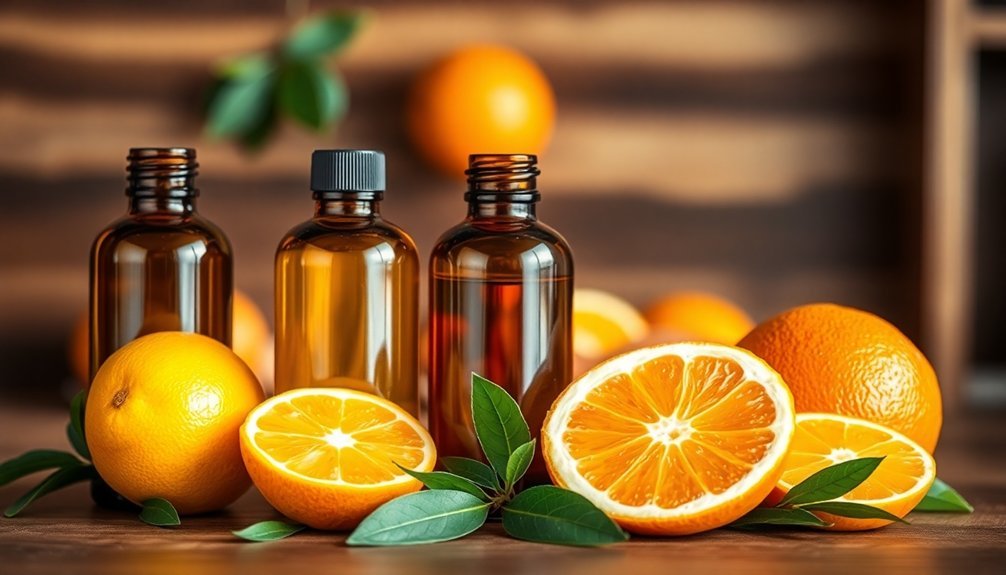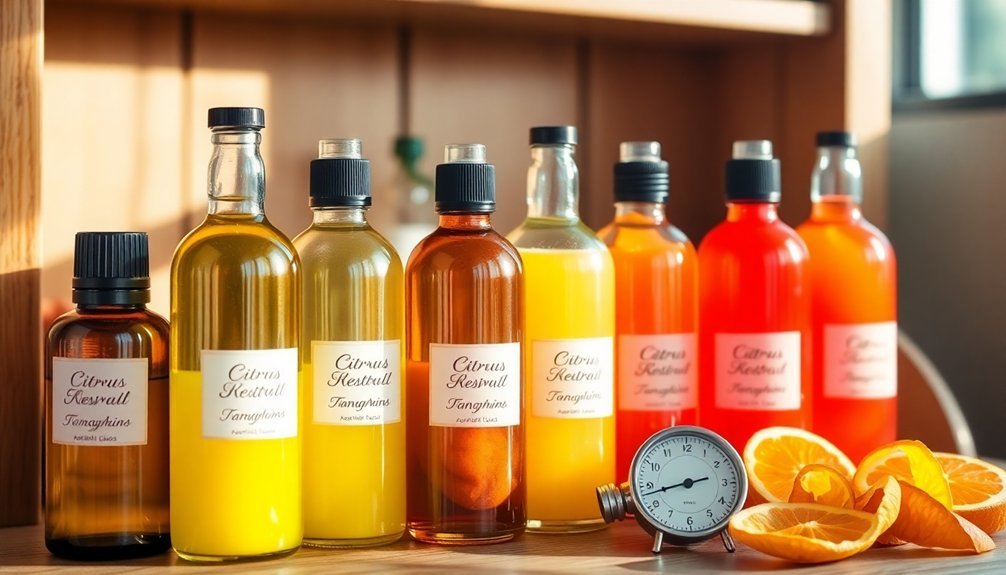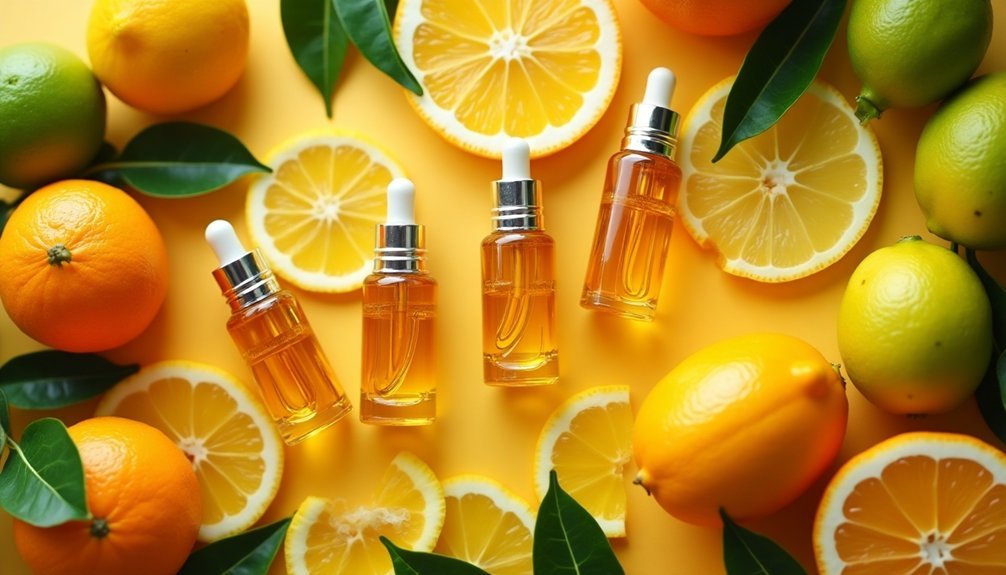You'll find endless possibilities when blending citrus essential oils for perfume bases. Start with popular combinations like orange-vanilla, grapefruit-rosemary, or lime-coconut to create uplifting scents. Layer your citrus oils with deeper base notes like vanilla or frankincense for longer-lasting fragrances, and follow the 4:2:1 ratio for top, middle, and base notes. For the best results, let your blends rest for 48 hours to develop their full aromatic potential.
Understanding Essential Oil Notes in Citrus Perfumes

Essential oil notes form the foundation of any well-crafted citrus perfume. When you're creating a fragrance, you'll need to understand how these notes work together in layers.
Citrus oils typically serve as top notes, delivering that initial burst of freshness you experience when first applying a perfume.
You'll find that citrus notes are highly volatile, meaning they evaporate quickly while creating an immediate sensory impact. This characteristic makes them perfect for opening notes, but you'll want to blend them with middle and base notes for a lasting fragrance. Using 100% authentic ingredients ensures the purest and most effective citrus aromatic experience.
Common citrus notes include lemon, lime, bergamot, and grapefruit, each bringing its unique character – from sharp and tangy to sweet and bitter.
While most citrus oils are fleeting, bergamot stands out with its earthier, spicier profile and longer-lasting presence.
Popular Citrus Essential Oil Combinations
When you're searching for summer-ready perfume blends, citrus essential oils offer endless possibilities for creating bright and energetic fragrances.
You'll find that orange-based combinations, like orange-vanilla or orange-bergamot mint, provide uplifting notes perfect for warm weather wear.
These mood-enhancing citrus blends can be further customized by mixing with florals, herbs, or tropical elements to create your signature summer scent. The addition of grapefruit and rosemary creates an invigorating herbal fusion that adds sophisticated depth to citrus perfumes.
Fresh Summer Scent Blends
Summer's vibrant energy comes alive through carefully crafted citrus essential oil blends that capture the season's essence.
You'll find tropical paradise in lime and coconut combinations, while lemongrass and sweet orange create an uplifting outdoor freshness perfect for long summer days.
For a beachy vibe, try mixing lime, lemon myrtle, and orange essential oils.
The blend of tangerine, bergamot, and eucalyptus offers a sweet, cooling treat that's ideal for hot afternoons. Combining 2 drops bergamot with other oils creates an enchanting seaside aroma.
Want something more exotic? Combine orange with ylang ylang and sandalwood to evoke a romantic summer sunset.
For an energizing start to your day, blend Jade Lemon, tangerine, and Citrus Fresh oils.
These combinations don't just smell amazing – they'll transport you to your favorite summer memories while keeping you refreshed and invigorated.
Mood-Lifting Citrus Combinations
Beyond their summer appeal, citrus oils offer powerful mood-lifting benefits that can transform your emotional well-being year-round.
You'll find several proven combinations that deliver consistent results. Try the Orange Punch blend with 5 drops sweet orange, 2 drops lemon, 3 drops grapefruit, and 1 drop bergamot for an instant mood boost.
For a simpler energizing blend, combine 3 drops sweet orange, 2 drops lime, and 2 drops mandarin.
If you're seeking balance, the Invigoratingly Calming blend mixes bergamot, ylang ylang, sandalwood, lavender, and lime.
For pure citrus enthusiasm, create an All Orangy blend using equal parts orange, blood orange, wild orange, and petitgrain.
These combinations work effectively in perfumes while supporting your emotional wellness through their uplifting properties.
Creating Long-Lasting Citrus Scent Profiles

Although citrus scents offer bright and invigorating qualities, their notoriously short-lived nature presents a challenge for perfume enthusiasts. You can extend their longevity by creating strategic blends that incorporate multiple fragrance layers and proper application techniques.
- Layer your citrus oils with deeper base notes like vanilla, frankincense, or myrrh to anchor the fragrance.
- Create double or triple infused oils using citrus peels and complementary herbs like lemongrass.
- Apply to moisturized skin at pulse points for maximum staying power.
To achieve the best results, you'll want to combine your favorite citrus oils with middle notes that bridge the gap between top and base notes.
Consider using essential oils like lemongrass or infused herbs to add depth while maintaining the bright citrus character you're seeking.
Blending Citrus With Complementary Scents
When creating enchanting citrus perfumes, you'll discover endless possibilities by pairing these bright notes with complementary scents. You can blend citrus with florals like lavender and rose to achieve a spring-like sweetness that balances vitality with calm.
For an invigorating boost, try combining citrus oils with herbs such as rosemary or mint, perfect for energizing morning routines.
If you're looking for longer-lasting fragrances, pair your citrus oils with woody notes like cedarwood or sandalwood. These combinations anchor the volatile citrus scents while adding depth and richness.
You can also create complex, vibrant blends by mixing different citrus oils together and adding spearmint for an extra revitalizing touch. Each combination offers unique benefits, from mental clarity to seasonal appeal.
Crafting Balanced Citrus Perfume Formulas

To create lasting citrus perfumes, you'll want to follow the proven 4:2:1 or 3:2:1 ratio of top, middle, and base notes while carefully selecting your natural fixatives.
Your selection of fixatives like Ambrocenide can help anchor the volatile citrus oils and extend their presence on the skin.
When choosing your components, you'll need to balance the fresh, energetic top notes with complementary middle notes and stabilizing base notes to achieve a harmonious blend that maintains its citrus character throughout its wear time.
Essential Ratios For Success
Creating balanced citrus perfume formulas relies on understanding key ratios and proportions that bring harmony to your blend.
Start with the classic 30-50-20 ratio: 30% top notes, 50% middle notes, and 20% base notes. You'll want to begin with small test batches of about 5 drops total, allowing you to adjust the blend without wasting precious oils.
- Combine 3 parts of a citrus top note (like Bergamot) with 5 parts of a floral middle note (such as Lavender).
- Add 2 parts of a grounding base note (like Frankincense or Cedarwood).
- Dilute your blend to 3% in your chosen carrier oil for daily wear.
Remember to let your creation rest for 48 hours, allowing the scents to mature and develop their full potential.
Natural Fixative Selection Guide
The art of fixing citrus notes requires careful selection of natural fixatives to extend their fleeting nature. You'll find resinoids particularly effective, with frankincense and myrrh being your primary choices for anchoring citrus accords.
While frankincense reinforces the brightness, myrrh provides depth and longevity to your blend.
For a modern approach, you can incorporate ambrocenide in trace amounts, especially when working with natural ingredients. It's most effective when used at 10% in DPG to create transparent, lasting citrus notes.
Don't overlook the power of layering – combine your citrus oils with complementary base notes like benzoin or elemi.
When pre-fixing your alcohol base, try using tinctures of resins to create a stronger foundation.
Remember to take into account phototoxicity when selecting your citrus oils.
Essential Safety Guidelines for Citrus Blends
When working with citrus essential oils in perfumery, proper safety measures can prevent adverse skin reactions and potential health risks.
You'll need to conduct patch tests and understand proper dilution ratios before creating your blends.
- Always perform a 24-hour patch test on your upper forearm before using any new citrus oil, watching for redness or irritation.
- Dilute your citrus oils properly – aim for 20% fragrance to 80% carrier oil ratio, or reduce to 15% for sensitive skin.
- Be mindful of phototoxicity – cold-pressed bergamot, lemon, lime, and grapefruit can cause sun sensitivity, while sweet orange and steam-distilled lime are safe.
Remember that citrus oils are highly concentrated and should never be applied directly to your skin.
Use high-quality oils and consider specific safety needs for vulnerable populations like children or those with health conditions.
Storage and Shelf Life of Citrus Perfumes

Proper storage can greatly extend the life of your citrus perfume blends, which typically last between 6 months to 2 years when protected from harmful elements.
You'll want to store your citrus blends in dark glass bottles with tight seals, keeping them in cool, dark places away from sunlight and artificial lighting.
Don't leave your bottles open longer than necessary, as oxygen exposure can degrade the fragrance.
Stick with the original packaging whenever possible, as it's designed to protect your perfume.
If you need to transfer your blend, do it quickly and avoid excessive shaking that introduces air bubbles.
Store your bottles in cupboards or drawers, and check them regularly for any changes in scent or appearance.
Remember that high temperatures and humidity can greatly reduce your perfume's shelf life.
Frequently Asked Questions
Can Citrus Essential Oils Stain Clothing or Jewelry?
You'll find that citrus oils don't typically stain clothes but can discolor fabrics if left untreated. They'll also damage your sterling silver jewelry through acidic reactions, so avoid direct contact with both materials.
How Do Seasonal Temperature Changes Affect Citrus Perfume Performance?
You'll notice your citrus perfume performs differently across seasons. In heat, it's more intense but evaporates quickly. In cold, it's subtler but lasts longer. Humidity helps lock the fragrance into your skin.
Are Synthetic Citrus Notes More Cost-Effective Than Natural Essential Oils?
Yes, you'll find synthetic citrus notes much more cost-effective than natural oils. They're cheaper to produce in bulk, maintain consistent pricing, and don't face seasonal price fluctuations like natural essential oils do.
Which Citrus Blends Work Best for Sensitive Skin Types?
You'll want to use steam-distilled or FCF citrus oils like Sweet Orange and Bergamot FCF, diluted to 3-5% with gentle carrier oils like Jojoba. Always patch test and avoid cold-pressed varieties.
Do Different Citrus Oils Have Varying Photosensitivity Levels in Sunlight?
Yes, each citrus oil has different photosensitivity levels. You'll find bergamot's the most reactive at 0.4% safe dilution, followed by lime at 0.7%, lemon at 2%, and grapefruit at 4% when cold-pressed.
In Summary
You're now equipped to create vibrant citrus perfume blends that'll last. Remember to balance your citrus notes with proper fixatives and complementary scents, always following safety guidelines for photosensitive oils. Store your creations in dark glass bottles, away from light and heat, and use them within their recommended shelf life. With these essential principles in mind, you'll craft memorable citrus fragrances that capture nature's brightness.
References
- https://basenotes.com/community/threads/base-notes-used-to-create-a-citrus-fragrance.409201/
- https://blog.simplyearth.com/best-essential-oils-for-perfume-making/
- https://allnaturalbeauty.com/how-can-i-make-a-citrus-blend-that-lasts-longer/
- https://dokumen.pub/the-citron-compendium-the-citron-etrog-citrus-medica-l-science-and-tradition-303125774x-9783031257742.html
- https://hiqili.com/blogs/recipes/essential-oils-for-perfume
- https://www.hearthandhomesteadstore.com/product-page/silk-road-citrus-natural-perfume-oil
- https://www.nisarabeauty.com/blogs/blogs/your-ultimate-guide-to-citrus-based-perfumes
- https://nikura.com/blogs/discover/essential-oil-notes-explained
- https://angelaflanders-perfumer.com/blogs/news/citrus-notes-in-perfumery
- https://www.olfactorynyc.com/blogs/news/citrus-in-fragrance-forever-on-top





Leave a Reply